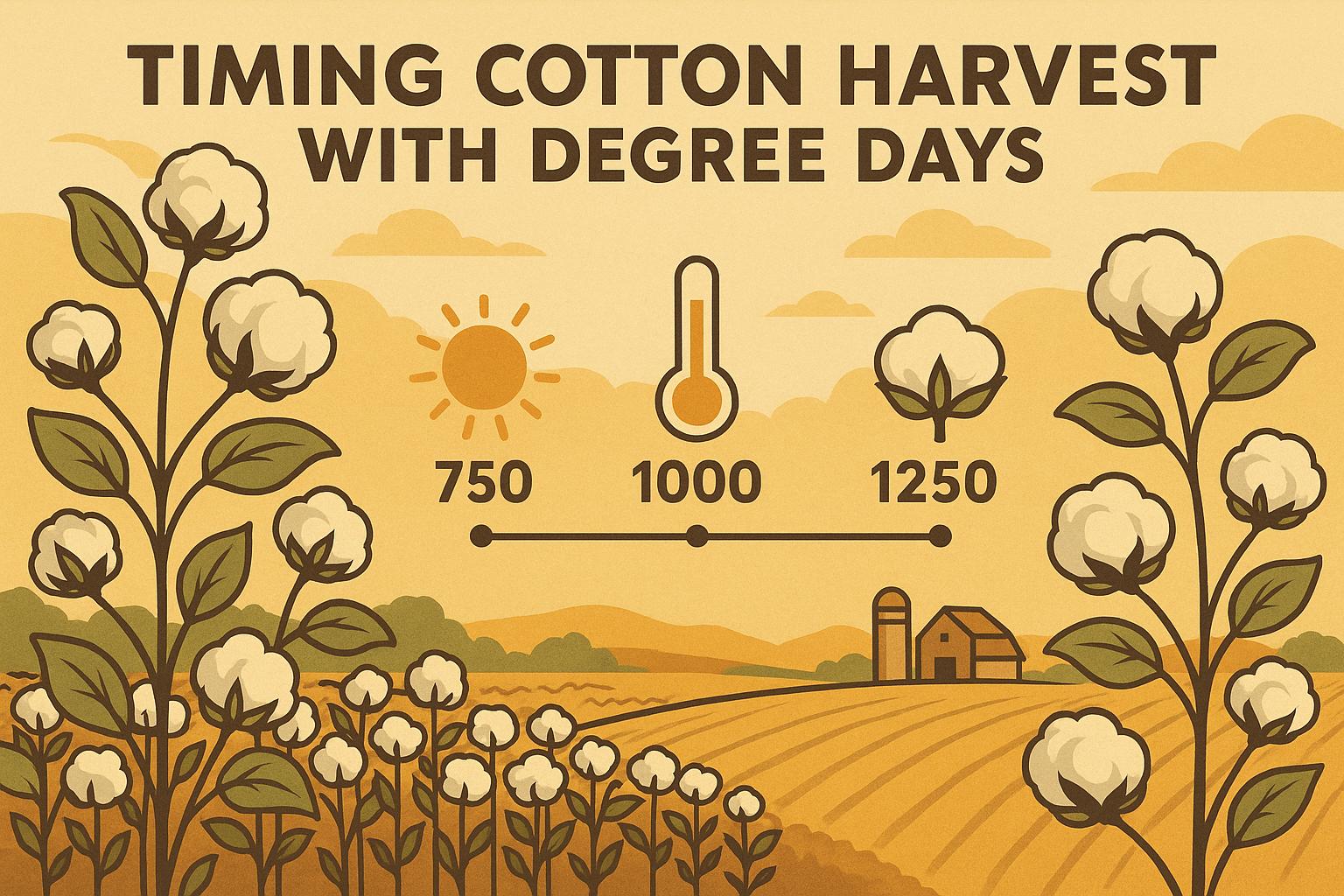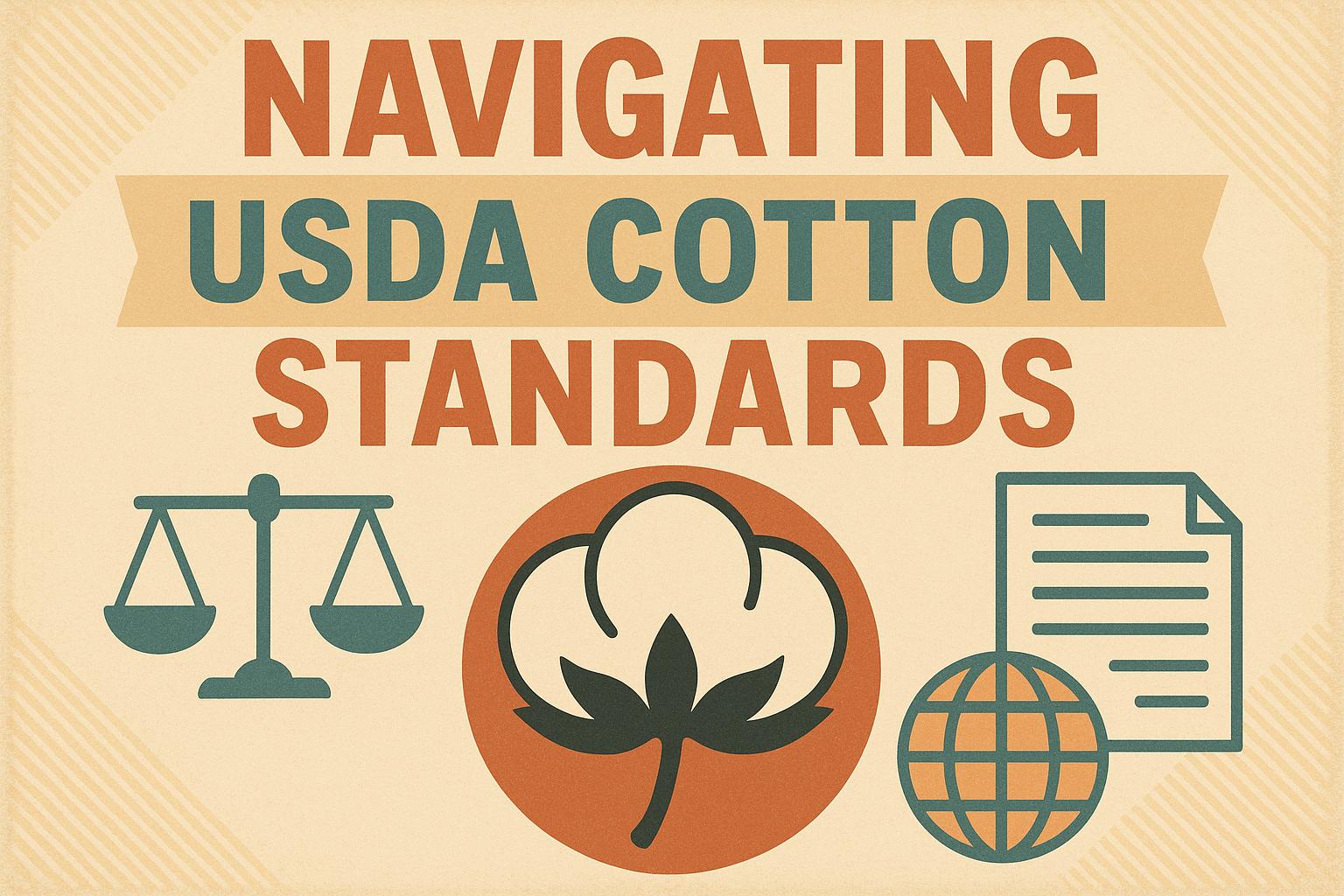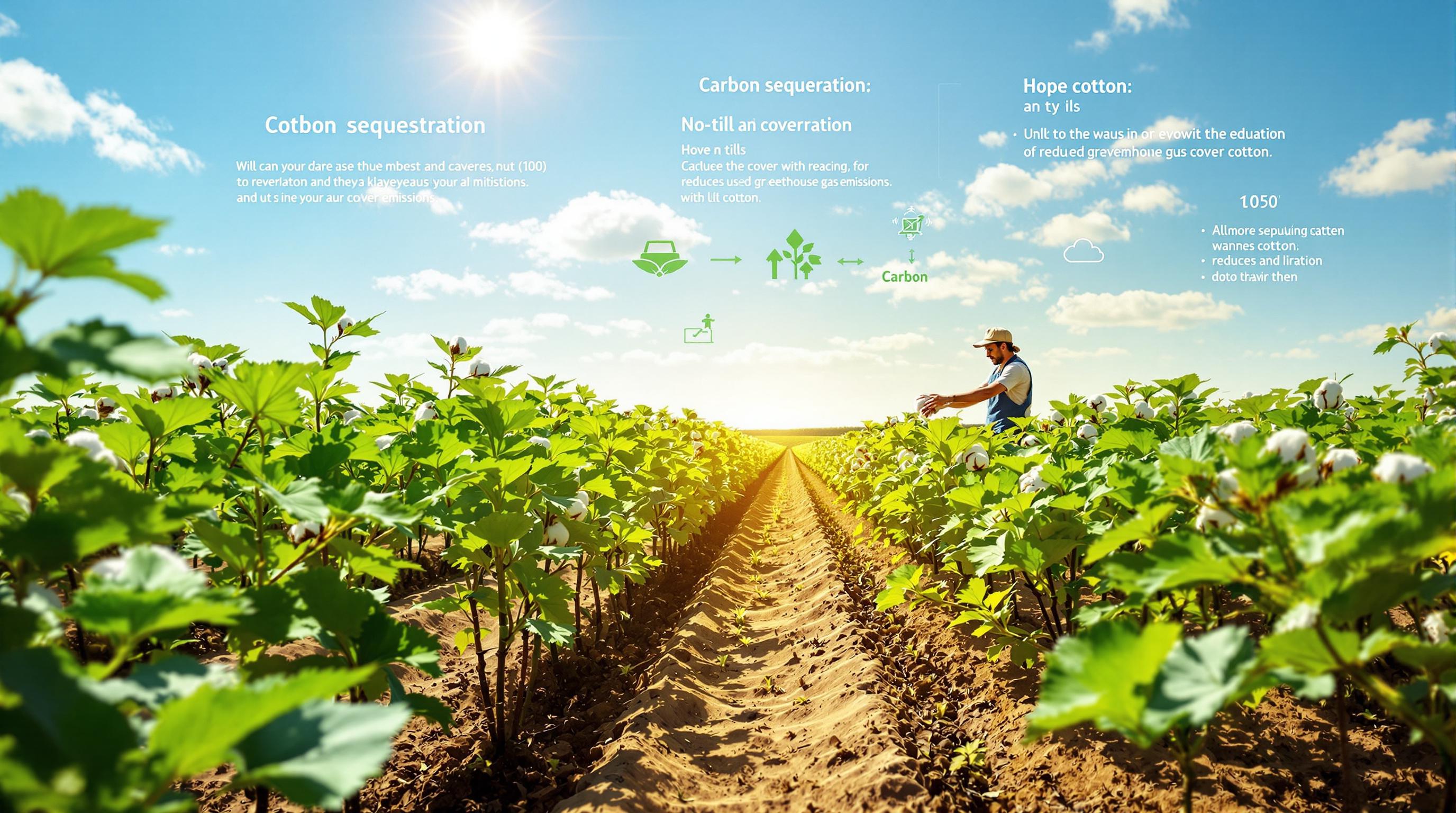Regenerative cotton certification ensures cotton is grown using farming methods that restore soil health, boost biodiversity, and support fair labor practices. These certifications help farmers access premium markets, reduce costs, and meet growing consumer demand for traceable, responsibly produced cotton. Key programs like Regenerative Organic Certified® (ROC) and the Regenerative Cotton Standard (RCS) set strict criteria for soil improvement, ethical labor, and transparent supply chains.
Highlights:
- Regenerative farming improves soil, reduces water usage, and cuts fertilizer costs.
- Certifications like ROC and RCS verify compliance through audits and measurable progress.
- U.S. consumer interest in regenerative cotton is growing, with sales up 20% in 2024.
- Certified cotton opens doors to premium pricing and long-term partnerships.
With demand rising and brands committing to regenerative sourcing, certification is a pathway to economic and environmental progress for the cotton industry.
What Is Regenerative Organic Certified?
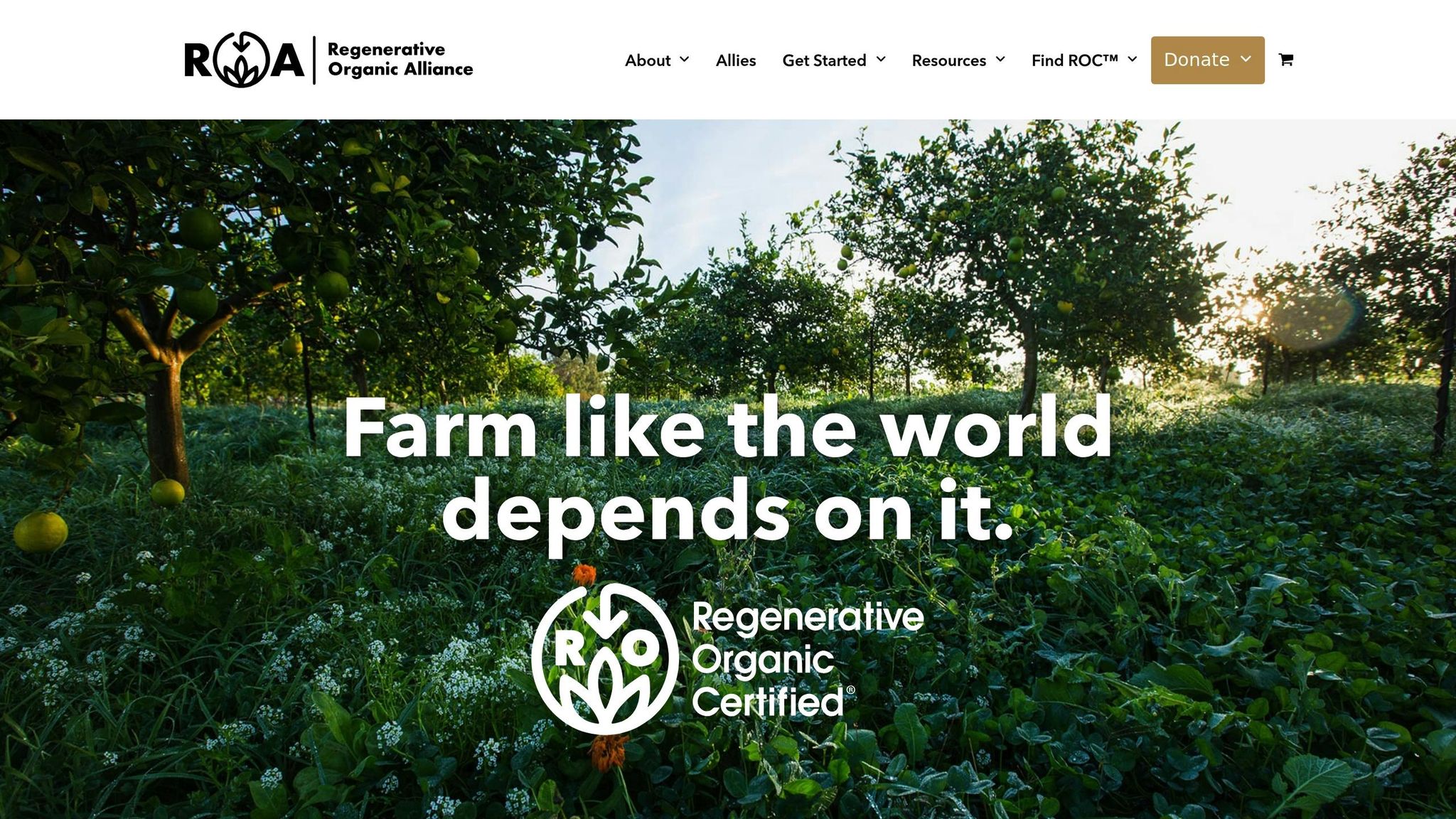
Major Regenerative Cotton Certification Programs
The regenerative cotton industry is supported by several certification programs that validate sustainable farming practices. These certifications not only help farmers showcase their dedication to soil health, environmental care, and social responsibility but also open doors to premium markets. Familiarity with these programs is essential for navigating the U.S. cotton market's sustainable landscape.
Regenerative Organic Certified® (ROC)
Regenerative Organic Certified® (ROC) builds upon USDA Organic standards with stricter criteria for soil health, animal welfare, and social equity. This certification ensures that cotton is produced under globally recognized organic guidelines approved by IFOAM, while also prioritizing soil regeneration, ethical treatment of animals, and fair treatment of farmers.
ROC offers three certification levels - Bronze, Silver, and Gold - each with progressively higher standards. Certification involves regular inspections and requires farms to demonstrate measurable improvements in soil health over time. By 2025, ROC has certified 370 farms and ranches, encompassing 66,511 smallholder farmers, 19,440,743 certified acres, and 2,523 certified products from 297 brands.
Dana Geffner, a board member of the Regenerative Organic Alliance, highlights the program's comprehensive approach:
"Regenerative organic farmers and ranchers can feed their communities and cool the planet - when they are supported and compensated fairly. ROC™ incorporates fair trade principles, making this holistic certification a critical framework for a healthy future."
Regenerative Cotton Standard (RCS)
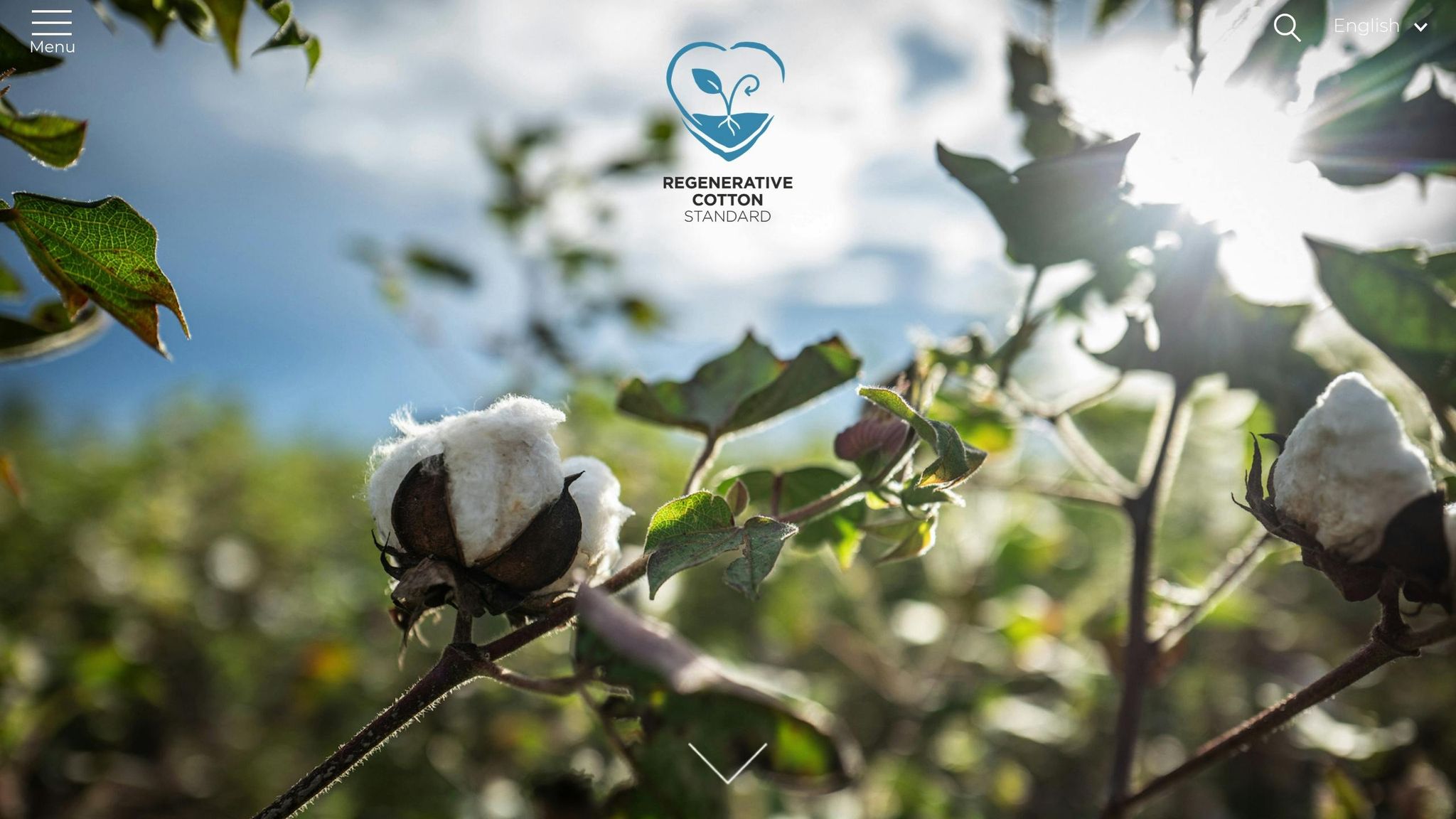
The Regenerative Cotton Standard (RCS) takes a systems-based approach, focusing on farm-level outcomes rather than just the cotton crop. Developed by the Aid by Trade Foundation, RCS emphasizes sustainable land management, social responsibility, and animal welfare. It defines regenerative agriculture as "actively creating co-benefits in interaction between nature, people, society, and the economy, bringing agricultural systems into a better state than they are currently in". Farms must show measurable progress in key indicators, ensuring that regenerative practices benefit the entire farming system.
Better Cotton Initiative (Transitioning to Regenerative)
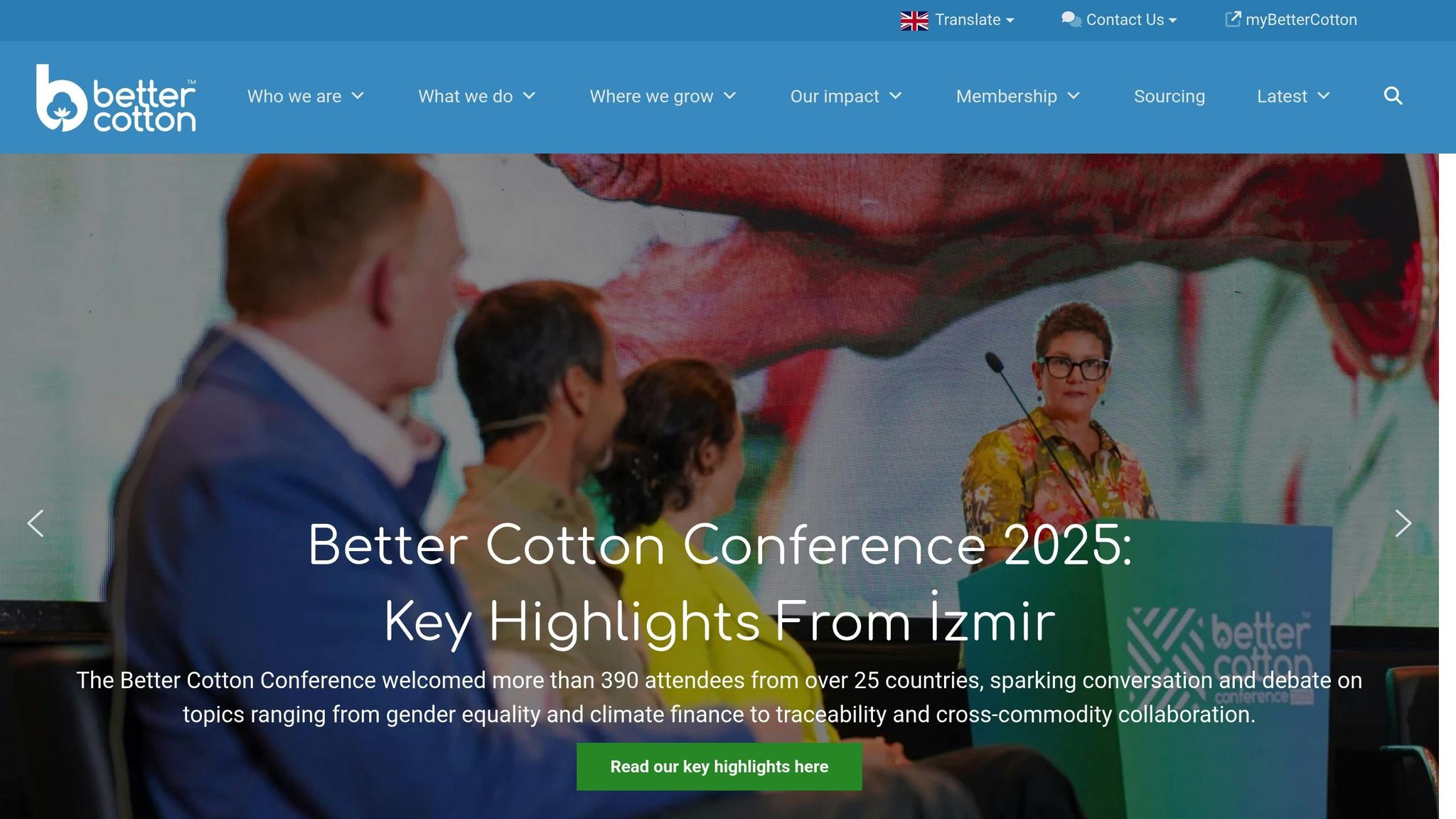
The Better Cotton Initiative (BCI), a leading global cotton sustainability program, is incorporating regenerative agriculture principles into its framework. This shift moves away from focusing solely on farming practices to emphasizing measurable environmental and social outcomes. Participating farms are now required to collect data and undergo third-party verification to demonstrate improvements. With its extensive presence in the U.S. cotton industry, BCI allows farms to transition from existing practices to more ambitious environmental goals while maintaining their current operations.
Regenified Certification
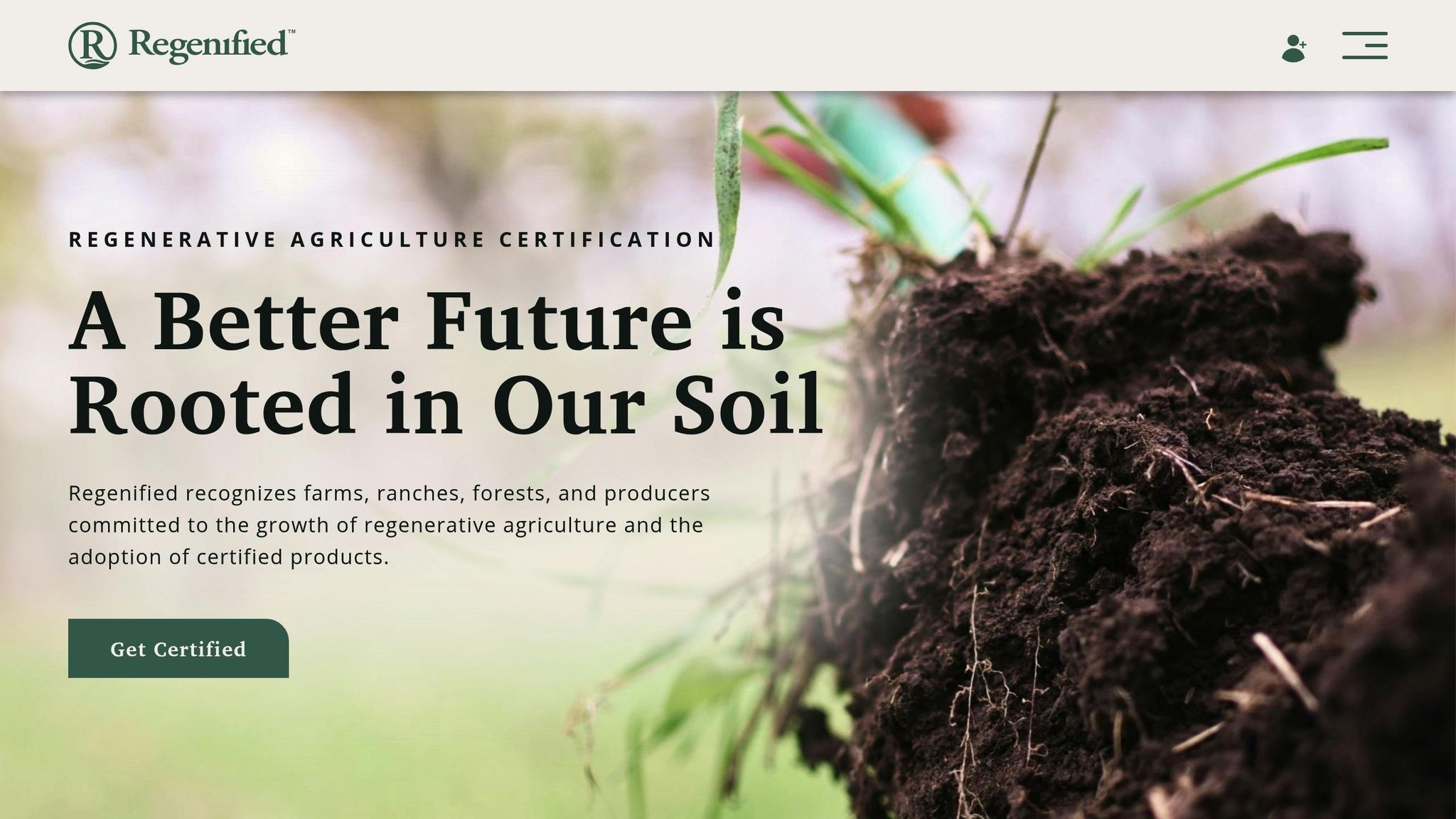
Regenified Certification uses a systems-based approach guided by the Regenified 6-3-4 Verification Standard, blending both practice-based and outcome-based criteria. The program prioritizes soil health, biodiversity, and ecological resilience. Farms must show tangible improvements in these areas, with assessments tailored to local ecosystems and conditions. This ensures that regenerative practices genuinely support the restoration of natural systems.
For cotton gins and producers aiming to align with sustainable practices, understanding these certification programs is essential for tapping into premium markets and fostering long-term partnerships.
Core Certification Requirements and Criteria
Regenerative cotton certification sets clear standards to encourage environmental restoration and uphold social responsibility. These guidelines help farmers and gin operators adopt practices that align with certification goals. Below, we explore the essential criteria, from improving soil health to ensuring fair labor practices.
Soil Health and Land Management
Healthy soil lies at the heart of regenerative cotton certification. Farms must show measurable progress in enhancing soil organic matter, structure, and biological activity. This is achieved through methods like:
- No-till or reduced-till farming: Protects soil structure and minimizes erosion.
- Cover cropping: Keeps soil covered during off-seasons, preventing erosion and maintaining fertility.
- Crop rotation: Replenishes soil nutrients with diverse plantings.
Regular soil testing plays a key role in tracking these improvements and guiding farm management. For instance, increasing soil organic matter by just 1% can enhance water retention by over 20,000 gallons per acre. Additionally, compost-enriched soils may cut nitrogen fertilizer needs by 15–30% compared to untreated soils. Integrated Pest Management (IPM) strategies further support sustainable practices by reducing reliance on chemical pesticides and promoting biological controls.
Social Standards and Labor Practices
Fair labor practices are a cornerstone of regenerative cotton certification. Programs like Regenerative Organic Certified™ (ROC) mandate that farms implement ethical labor standards, including fair wages for workers. Before applying for regenerative certification, farms are typically required to hold baseline social fairness certifications from recognized organizations. This ensures that social responsibility is embedded in the certification process.
Verification and Auditing Processes
Earning regenerative cotton certification involves a thorough and transparent verification process. Farms must submit detailed applications, including parcel maps, organic system plans, and any existing certifications. A key component is the Regenerative Organic System Plan, which outlines current practices, goals, and strategies for improving soil health and labor conditions.
Independent certifying bodies, approved by the Regenerative Organic Alliance (ROA), conduct comprehensive on-site audits. These audits include:
- Field inspections to observe farming practices.
- Reviews of documentation to ensure compliance.
- Interviews with farm personnel to verify adherence to standards.
Soil testing is conducted during the first year to establish a baseline for future comparisons. Certification decisions go through multiple review stages, with auditors submitting reports and recommendations to the certifying organization. Third-party verification ensures that farms are genuinely committed to regenerative practices.
These rigorous standards not only validate the integrity of certified regenerative cotton but also provide confidence to cotton gins in managing certified materials throughout the supply chain.
sbb-itb-0e617ca
Benefits of Certification for Farmers and Businesses
Certification brings a range of advantages, from opening doors to premium markets to reducing operational costs and improving supply chain visibility. These benefits create value not only for farmers but also for businesses aiming to meet growing consumer and regulatory demands.
Market Access and Premium Pricing
Certification standards often translate into financial rewards. One major perk is premium pricing, as brands are willing to pay more for verified regenerative cotton.
Incentives for adopting regenerative practices are on the rise. For instance, ADM and PepsiCo have teamed up to offer farmers $3 per acre on up to 7 million acres by 2030, with an additional $1,000 for those who allow carbon storage testing and monitoring.
McKinsey's research highlights that regenerative agriculture practices on U.S. corn and soy farms could generate $20 to $60 per acre annually during the first decade. While these figures focus on other crops, cotton farmers can expect similar opportunities as certification programs expand.
Government support also plays a role. In 2022, U.S. cotton producers received $1.47 billion in premium subsidies, providing certified farmers with access to additional funding aimed at sustainability initiatives.
Farming and Economic Benefits
The financial upside of certification goes beyond market premiums. Regenerative practices often lead to long-term economic gains through reduced input costs. For example, farmers can cut fertilizer and pesticide expenses by as much as 20%.
Real-world results back this up. Cotton Connect's REEL Regenerative program, which trained over 250,000 farmers in 2023–2024, reported yield increases of 4%, input cost reductions of about 10%, and a 14% drop in water usage. In Maharashtra, India, farmers in the REEL Regenerative Organic Cotton program saw profits rise by 4.9% compared to control groups, thanks to 35% lower input costs despite slightly lower yields.
Pairing practices like no-till farming with cover cropping has shown even greater results. Farmers who adopt these methods can achieve yields that are 10–30% higher than conventional approaches, along with average cost savings of $47 per acre and net income boosts of $100 per acre.
Water conservation is another major advantage. Regenerative farming methods can slash water use by 30–50%, which not only reduces irrigation costs but also helps farmers become more resilient to drought conditions.
"My safety net is the resiliency built into my soil. My safety net is the health of the operation. My safety net is the fact that I don't rely on only one or two commodities to make my income. We have 17 different enterprises on our ranch now. So I'm resilient - our ranch is resilient - because of the diversity and because of the health of the ecosystem. That's very liberating." – Gabe Brown
Supply Chain Transparency for Businesses
Certification also strengthens supply chain transparency, which is increasingly important for meeting consumer expectations and regulatory requirements. Through Hard Identity Preserved systems and online tracking, the Regenerative Cotton Standard (RCS) ensures complete traceability from the ginnery to the end product.
Brands are already scaling up their use of regenerative cotton. J. Crew, for example, expanded its program from 600 acres in 2021 to 129,000 acres across six states by 2024, quadrupling the amount of regenerative cotton sourced annually.
Similarly, Stella McCartney’s collaboration with SOKTAS showcases how certification fosters long-term partnerships. Since 2019, SOKTAS has grown its regeneratively farmed land from 12 acres to 136 acres, with plans for further expansion. This partnership provides Stella McCartney with 100% traceability from farm to finished product.
Technology like blockchain is also making it easier for companies to verify sustainable practices. By integrating this technology, businesses can trace products back to their origins, ensuring transparency and accountability.
"The data helps us tell the story in a way that's transparent and accountable. It gives us credibility as we navigate environmental and market pressures." – Cannon Michael, president of Bowles Farming Company
For cotton gin operators, tools like cottongins.org simplify the process of finding certified regenerative cotton sources. This directory connects businesses with facilities handling certified materials, supporting the growing demand for traceable, sustainable cotton.
"For us, Climate Beneficial™ was a way to move from a sustainability story to a traceability story. We know exactly where this cotton was grown, who grew it, and the practices they used. That's a value our customers can see and feel." – David Roshan, president of Laguna Fabrics
Conclusion
Regenerative cotton certification standards present a game-changing opportunity for the U.S. cotton industry. They tackle the pressing need for improved farming practices while offering economic benefits to farmers, businesses, and consumers.
The numbers tell a compelling story. Conventional agriculture is responsible for up to 25% of the emissions fueling the climate crisis. Meanwhile, U.S. cotton has already cut its greenhouse gas emissions by 25% since 1980. Certification programs build on this progress, offering a structured way to drive even greater environmental improvements.
But it’s not just about the environment - it’s also about economics. A striking 71% of consumers are willing to pay more for clothing made from sustainable materials. Certification ensures traceability and accountability, which are increasingly essential in today’s supply chains. This gives brands and consumers confidence that their sustainability promises result in measurable impact.
The industry is already moving in the right direction. Between 2012 and 2017, the use of cover crops rose by nearly 50%. Additionally, about 45% of U.S. cotton farmers now use reduced or no-till practices. Healthy soils, which can store up to 250 million metric tons of carbon annually, demonstrate the enormous potential for environmental benefits. These trends underline the growing momentum behind regenerative practices.
Key Takeaways
Regenerative cotton certification standards bring benefits across the board. Farmers gain access to premium markets, lower their input costs, and build resilience to climate challenges. Businesses profit from transparent supply chains that meet rising consumer demand for sustainably produced goods. And the environment benefits from healthier soils, richer biodiversity, and reduced greenhouse gas emissions.
As Jeremy Brown, a regenerative organic cotton farmer, eloquently explains:
"It's about giving back to the soil, creating a living system that keeps functioning season after season. It's about taking care of the land, because the land takes care of us."
Programs like Regenerative Organic Certified® and the Regenerative Cotton Standard provide clear pathways for scaling these efforts. Tools such as cottongins.org help cotton gin operators and supply chain partners connect with certified sources, making participation in this movement more accessible.
Certification isn’t just about improving the bottom line - it’s about ensuring the environmental and social integrity of the cotton industry. Regenerative practices are the future of U.S. cotton, and certification standards provide the roadmap to make this vision both achievable and profitable. The real question now is: how quickly can the industry scale these efforts?
FAQs
What are the key differences between Regenerative Organic Certified® (ROC) and the Regenerative Cotton Standard (RCS), and how do they benefit farmers?
The Regenerative Organic Certified® (ROC) program zeroes in on three key goals: boosting soil health, ensuring proper care for animals, and advocating for fair treatment of farmers and workers. Building on USDA organic standards, it introduces three certification levels - Bronze, Silver, and Gold - designed to motivate ongoing progress. For farmers, this certification not only acknowledges their dedication to responsible practices but also opens doors to premium markets.
On the other hand, the Regenerative Cotton Standard (RCS) is crafted specifically for cotton farming, with a strong focus on small-scale farmers. It emphasizes practices like improving soil health, fostering biodiversity, and minimizing environmental harm. By validating these regenerative practices, RCS helps farmers enhance their livelihoods and supports the long-term sustainability of cotton production.
While both certifications aim to address environmental and social challenges, ROC offers a broader framework that applies to various crops, whereas RCS hones in on the specific needs of cotton farmers.
How do regenerative cotton certification programs ensure farms follow their standards, and what role do audits play?
How Regenerative Cotton Certification Programs Ensure Compliance
Regenerative cotton certification programs maintain high standards by conducting regular audits performed by independent evaluators. These audits involve on-site inspections, detailed reviews of farm records, and evaluations of practices such as soil health management, crop rotation, and sustainable land use. This rigorous process ensures that farms consistently uphold the principles of regenerative agriculture.
Audits play a key role in preserving the integrity of certification programs. By offering an unbiased assessment of a farm's compliance with established standards, they help pinpoint areas that may need improvement while confirming continued adherence. To ensure transparency and accountability, both scheduled and surprise audits are employed, fostering trust among farmers, businesses, and the broader community in the certification process.
What financial benefits and market opportunities are available to farmers who adopt regenerative cotton practices?
Farmers who adopt regenerative cotton practices stand to gain financially in several ways. One of the most immediate perks is premium pricing for their cotton, allowing them to earn more compared to conventional cotton growers. On top of that, initiatives like the USDA's Partnerships for Climate-Smart Commodities provide technical and financial assistance, making the transition to these practices smoother and more sustainable.
Switching to regenerative methods can also lead to brand collaborations with companies focused on sustainability. These partnerships often translate into long-term contracts and more stable markets. Beyond just boosting income, they position farmers as trailblazers in environmentally conscious agriculture.
